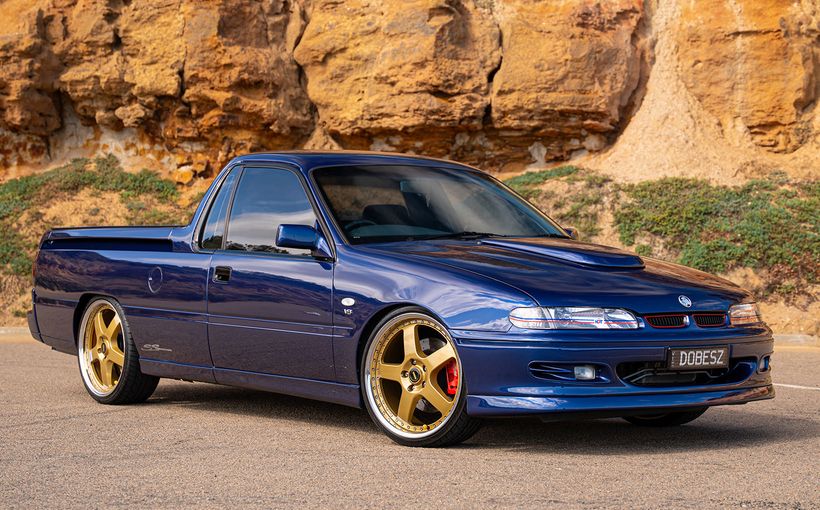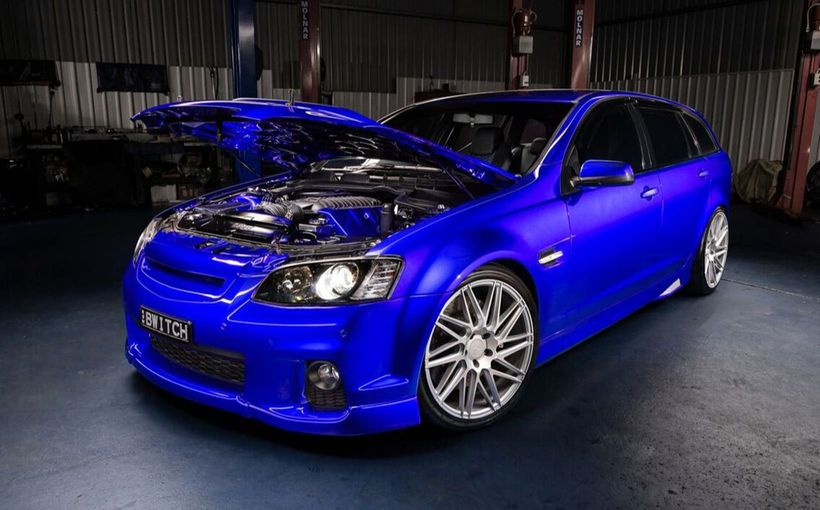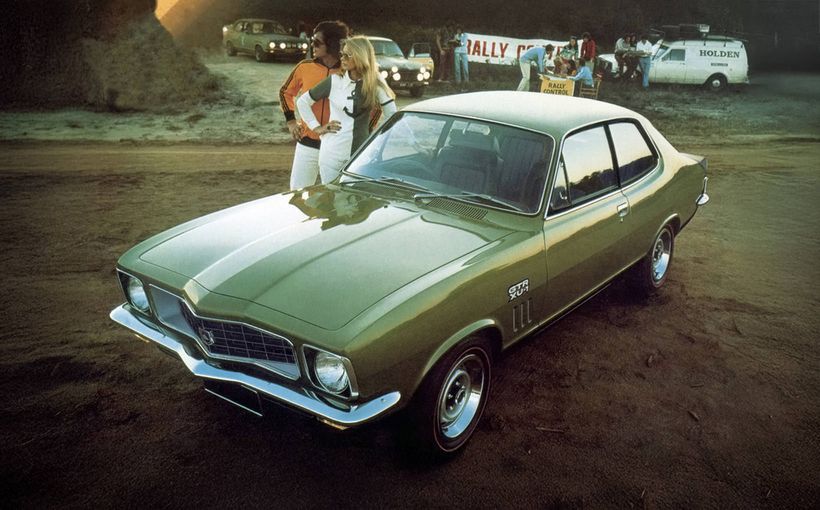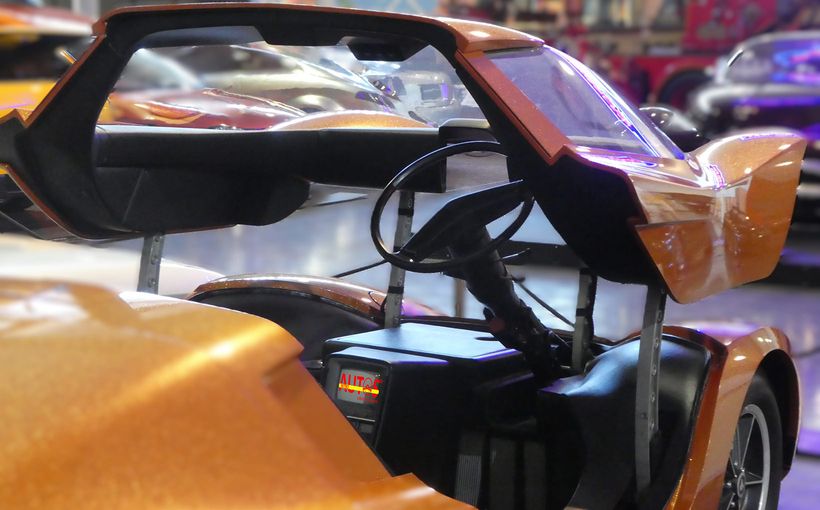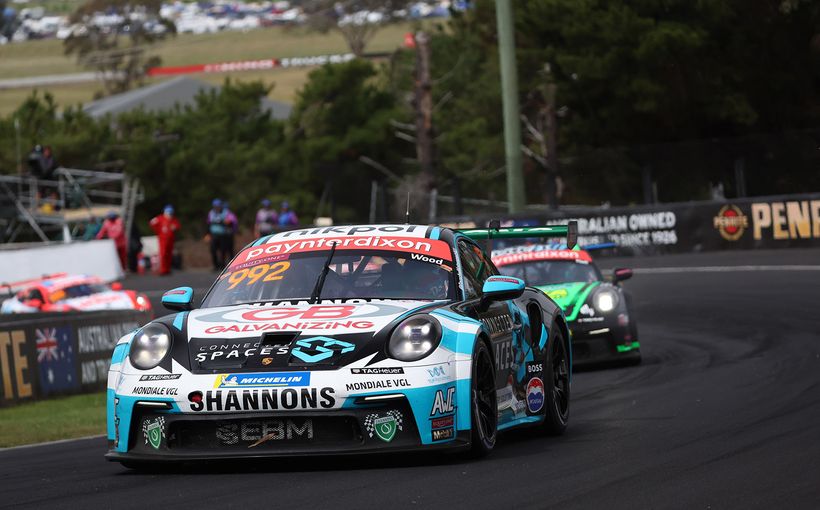Holden VN Commodore SS Group A: Taking a pocket knife to a gun fight

Hard charging Win Percy gets plenty of air under the inside tyres as he pounds the Holden Racing Team’s VN SS Group A across the kerbing at Oran Park’s Dogleg during the 1991 ATCC. Straight-lining corners like this certainly looked spectacular, but had little effect on results when competing against a far superior opponent from Japan.
If Holden’s last Group A Commodore had been equipped with a pair of turbochargers and an all-wheel drive transmission, it might have stood a chance of beating Nissan’s all-conquering R32 Skyline GT-R. The fact that it had neither meant it faced an unfair fight from start to finish.
When Nissan unleashed the GT-R in 1990, Australian touring car racing faced an unprecedented challenge. Nissan had exploited every freedom in the FIA rule book to produce what was unquestionably the definitive Group A touring car.
Armed with a 2.6 litre DOHC 24-valve inline six equipped with dual turbochargers, the Japanese super coupe was capable of producing a staggering 700 bhp in full boost qualifying trim. This was fed through a six-speed gearbox to a sophisticated all-wheel drive transmission, with an electronically controlled central diff that continuously varied the torque split between front and rear axles to maximise traction according to track conditions.
Not surprisingly, the Japanese monster soon earned the nickname ‘Godzilla’ as it stomped a path of destruction through its first full season in 1991. The GT-R’s rear wheel drive victims included the nimble BMW M3, the previously dominant Ford Sierra Cosworth RS 500 and Holden’s final factory-built race special – the VN Commodore SS Group A.

Nissan’s awesome R32 Skyline GT-R. The twin-turbocharged all-wheel drive super coupe was vastly superior to its rear-wheel drive opposition, resulting in two ATCC crowns and two Bathurst 1000s in two seasons. Interesting to note that had the GT-Rs not been there, Tony Longhurst’s BMW M3 would have claimed the 1991 and 1992 titles - and the VN Commodore SS Group A would have been a Bathurst winner.
Attempts by the sport’s governing body CAMS in 1992 to reduce the Nissan’s grossly unfair performance advantage, with increased minimum weight limits and turbo boost restrictions, had a noticeable effect but not enough to level the playing field.
The sobering fact that the VN claimed only one race victory in the Australian Touring Car Championship during its relatively brief two-season career speaks volumes about how lop-sided Group A racing had become in its dying days.
The GT-R was despised by rivals. One of its most outspoken critics was Commodore driver Larry Perkins. He wasn’t alone in his criticism of the sport’s administrators in allowing a twin-turbo all-wheel drive supercar to compete against ‘conventional’ touring cars like the Commodore in the first place.
The international Group A rules were already headed for the shredder in 1991, due to be replaced by a new domestic V8-based touring car category in 1993 (aka V8 Supercars). Even so, despite the GT-R’s palpable performance advantage, Holden fought hard to be the best of the rest. The fact that the VN Commodore SS Group A was only beaten by the GT-R at Bathurst in 1991 speaks volumes about The General’s resolute commitment

After several years in exile Peter Brock returned to the Holden stable (albeit without factory support) in 1991, headlining a two-car team backed by Mobil and engineered by former HDT team-mate Larry Perkins. The VN Group A’s stylish body kit, which included front and rear spoilers, side skirts, bonnet bulge, small front wheel-arch extensions (not fitted here) and ‘letter box slot’ grille, helped to improve straight line speeds but lacked downforce.
Homologation headaches
Following the collapse of the first and only World Touring Car Championship for Group A cars in 1987, the category was effectively finished as a global touring car formula by 1988. Even so, Australia continued to abide by the FIA’s outdated Group A rule book until the end of the 1992 season.
So, the design and development of the VN Commodore SS Group A was dictated by the long standing rule that required production of a minimum of 5000 base vehicles, which in Holden’s case was the V8-powered VN Commodore SS.
Those 5000 cars were required to determine that the model to be raced in Group A was indeed based on a mass-produced sedan. The rules then allowed for an evolution of the VN SS to serve as the basis of Holden’s competition car and which needed to be ‘homologated’ (approved) by the FIA.
These evolution cars or ‘homologation specials’ had to be built in a minimum of 500 units and incorporate all the major competition hardware the manufacture wanted to race with (block, heads, crank, rods, inlet and exhaust manifolds etc), bodywork additions (spoilers, side skirts, rear wings etc) and any other components required under the rules. Oh - and they also had to be fully street legal!

Sydney’s Bob Forbes Racing commenced the 1991 ATCC with a VN SS Group A for Mark Gibbs, but by the final round the team had switched to a ‘customer’ GT-R and went on to win the Sandown 500. Gibbs returned to the VN in 1992 when the GIO Nissan was briefly withdrawn, due to safety concerns following a mid-season increase in weight penalties.
Holden, thankfully, was given an official pardon by CAMS from this expensive, time-consuming and (by 1991) irrelevant task. By the time production of the 500 VN Group As had begun in 1990, the category was on death row and Australia was suffering an economic recession. GM-H told CAMS that selling 500 of those cars would be very difficult.
So in March 1991, when only 300 had been built, CAMS and Holden came to an agreement to cease production of a car which was now surplus to requirements. Given the extensive design and engineering that had gone into it, the futility of Holden’s efforts was not lost on senior management at a time when the company was drowning in red ink.
At least all the hard work had resulted in a car that surpassed the performance level of its predecessor - the VL SS Group A – in three key areas outlined by race teams. Firstly, they wanted the 4.9 litre fuel injected V8 to be safe at 8000 rpm and produce more power to offset the turbo advantage. Secondly, they wanted to exploit the new VN body’s slippery aerodynamics. And thirdly to optimise the fat 12-inch wide racing tyres.
However, motor racing is a volatile business in which rules can change with the stroke of a pen. And if Holden felt its efforts in producing the VN SS Group A had been largely wasted, rule changes prior to its track debut in 1991 made them seem even more futile.

Driver/engineer Larry Perkins, like his team-mate Peter Brock, found the going tough in 1991 in the face of the Nissan GT-R juggernaut. The new team faced a race against time to build two new cars for the start of the ATCC and had to use off-the-rack Dunlops until Brock’s new tailor-made Bridgestones arrived later in the year. Here Larry’s pushing hard with two off the deck at Brisbane’s Lakeside Raceway.
Race development
CAMS shocked race teams and manufacturers by announcing sweeping changes in late 1990 for the 1991 season. At the core of these new rules was an ill-conceived attempt to reduce the performance advantage enjoyed by turbocharged cars, by giving naturally aspirated cars – particularly the new VN Commodore - much lower minimum weights and new engine freedoms.
The lower weights looked great on paper, with the new VN allowed to race at a minimum of 1250 kgs. That was a substantial drop of 75 kgs from the minimum specified for the previous VL Group A race car at 1325 kgs.
And central to the new engine liberties was a rule stating that the induction system before the cylinder head and the exhaust system after the cylinder head were now free. So in a heartbeat a lot of the Group A development work put in by Mike Webb, Warwick Bryce, Paul Whitehead and others at the Holden Engine Company (HEC) had been for nothing.
Holden’s race teams would have to start all over again to take advantage of such freedoms, which would prove both costly and without any net gain in competitive terms as they were still on a hiding to nothing against the GT-R.

Sydney-based Commodore stalwart Terry Finnigan drove this VN SS Group A in 1991-92. Although the Sydney privateer raced with a tight budget, his cars were always immaculately presented. Here Terry’s VN is displaying the two-wheeling cornering dynamics often displayed by VNs during this period. The grip from 12-inch wide racing tyres caused some alarming body roll, which suggests the road car suspension geometry and narrow track weren’t ideally suited to the higher lateral grip levels provided by such sticky rubber.
For 1991 the VN Group A’s injected V8, an improved version of the engine which had powered HRT to a Bathurst victory with its VL the previous year, would be very different in configuration.
The twin throttle-body Group A inlet manifold, which thanks to HEC was now much lighter with more streamlined inlet runners, was instantly redundant. It was replaced by a custom-made cross-ram pure racing manifold, with each of the eight ram tubes having its own butterfly throttle and fuel injector. This set-up was typically sealed in a composite fibre cold air box, with snorkels on each side feeding gobs of fresh air from high pressure aero zones behind the headlights.
And the Group A stainless steel exhaust extractors, which had ended in short FIA-approved exhaust stubs from which race teams could fit their own exhaust systems, were also flung in favour of custom-made big bore extractors designed with only racing in mind.
Fortunately some of HEC’s development work, in making the engine strong enough to sustain the 8000 rpm-plus rev limits, wasn’t entirely wasted. The rugged cast-iron four-bolt main engine block had increased casting thickness in the usual critical stress zones. These included the upper cylinder bore area to allow the cylinder head bolts to tap deeper into the block at extreme torque loadings without distorting the joining surfaces between the block and heads.

TV commentator and race driver Neil Crompton had a brief fling with the Mobil Commodore team in 1992, after Brock and Perkins had parted ways after one season. Sadly for Neil the deal only lasted for the first and second rounds of the ATCC, before funding shortfalls reduced the team to one car. Here Crompton leads Brock at the season opener at Amaroo Park.
HRT engine man Rob Benson put this block to the ultimate destructive test in late 1990, when he told lead driver Win Percy to rev the engine to a shattering 9000 rpm during track testing. At those colossal revs, the Group A block cracked and the rear main bearing cap fell out with a big lump of broken block attached! From then on, 8500 rpm was determined as the safe redline, which was still very high for a genuine production-based pushrod V8.
HEC also beefed up the cast crankshaft and connecting rods to ensure they were safe to run at 8000 rpm, but Benson found they were actually too heavy for racing as engine acceleration was slowed too much because of their high reciprocating mass. HRT experimented with lighter VL Group A rods and cranks to find the best balance of strength and weight.
As pistons were free under Group A rules, Benson used super light Wiseco pistons from the US custom-made to his own ‘lumpy top’ design. Special gas-filled metal O-rings notched into the top of each cylinder bore provided the strength required to contain the sky-high 13.5:1 compression ratio.
Given that the VN SS Group A road car was factory rated at 215 kW (288 bhp) at 5200 rpm and 411 Nm (303 ft/lbs) of torque at 4000 rpm, this engine’s incredible transformation for racing resulted in almost double the power output. In 1991 HRT’s full-house VN race engine had 565 bhp (421 kW) at 8250 rpm with a safe 8500 rpm redline and around 450 ft/lbs (607 Nm) of torque at 5500-6000 rpm.

Another VN SS Group A runner in the early 1990s was Sydney privateer Bob Pearson. This nicely turned-out Commodore was a customer car built by Perkins Engineering and backed by Pearson’s thriving air conditioning company. He teamed with Great Race veteran Bruce Stewart for the 1991 Bathurst 1000, but after a troubled weekend the car crashed out of the race after 48 laps.
Getting all this V8 grunt to ground was a multi-plate competition clutch and the locally made but world class six-speed racing gearbox designed and built by Melbourne’s Peter Holinger, with rugged straight-cut gear sets and dog-clutch engagement.
To shave precious hundredths of a second per lap, Percy was ‘flat-shifting’ this tank-tough tranny in the VN. That is, he was holding the throttle pedal flat to the floor without lifting as he banged each shift through at lightning speed, using a soft rev cut at 8250 rpm (programmed into the electronic engine management system) as his shift point each time.
A two-piece tail shaft connected to a coil-sprung live rear axle located by rose-jointed upper and lower trailing arms and a lateral locating device. The fully locked spool-type diff comprised a Ford nine-inch crown wheel and pinion, Harrop fine-splined axle shafts and full floating hubs with heavy duty CV joints that allowed a range of rear wheel adjustment for camber, toe-in etc. Up front was a pair of competition-tuned MacPherson struts.
HRT’s VN Group A also featured enormous 14.68-inch diameter ventilated front disc rotors and AP six-pot callipers, carbon-metallic pads and water cooling.

Holden’s star performers at the Mountain in 1991 were reigning Bathurst champions Win Percy and Allan Grice. Although outgunned by the winning Richards/Skaife Nissan GT-R all weekend, HRT never gave up the fight. Grice/Percy were the best of the rest, finishing a fighting second and endorsing the VN’s racing credentials in the most important race of the year.
17 x 11-inch cast magnesium wheels, originally developed by HRT and Kevin Drage for the 1990 Bathurst winning VL Group A, were carried over to the VN and fitted with 12-inch wide racing tyres. The Group A’s rear wheel arches were unique in the VN Commodore line-up, as they were 25mm wider than regular models to accommodate these big boots.
The base VN body shape, even though larger in every external dimension than the VL it replaced, had an excellent Cd (aero drag co-efficient) of 0.34. This was way under the base VL’s 0.40 and equal to the VL Group A with its 18-piece aero body kit developed by Tom Walkinshaw Racing (TWR) in the UK’s MIRA wind tunnel.
For racing, Holden wanted to exploit the VN’s inherent ‘slipperiness’ with an even lower Cd balanced with a useful amount of negative lift or downforce at high speeds. Holden designer Phil Zmood worked with TWR to come up with a more visually pleasing 16-piece body kit that dropped the base VN Cd from 0.34 to an even better 0.30.
As a result the VN Group A racer was a bullet in a straight line, but that placed a greater premium on braking performance as the cars were arriving at corners at higher speeds than the VL.
The streamlining also came at a cost, in terms of reduced high speed stability. Top Holden drivers of the era recall that the VN lacked the more reassuring downforce of its VL predecessor, particularly when travelling at 280 km/h-plus on Conrod Straight. Larry Perkins recalled that the VN was not a nice car to drive, mainly because it was lacking in downforce. Period Racecam vision of VN rear-ends dancing around at high speeds remain vivid.

Up, up and away! Steve Reed could have been auditioning for Holden’s Precision Driving Team as he balanced the Dulux Autocolor VN SS Group A on two wheels at Sydney’s Oran Park in 1991. Reed and co-driver Trevor Ashby ran the thriving Lansvale Smash Repairs business in Sydney’s west, which helped to fund their touring car racing on weekends.
As mentioned earlier, the rule freedoms introduced for 1991 allowed the new VN Commodores to run a minimum weight of 1250 kgs. However, given that race teams had struggled to get the smaller and lighter 1410 kgs VL down to a minimum weight of 1325 kgs the previous year, trying to find another 75 kgs in weight savings within the larger and heavier 1557 kgs VN was a tall order. Overall it required a massive 300 kgs to be removed from the road legal equivalent.
Even so, HRT under chief engineer Wally Storey got its first VN Group A racer down to a relatively anorexic 1257 kgs. However, to achieve that was a very expensive and time-consuming task that required the Holden plant to make a batch of lightweight panels, bumper beams and thinner window glass. And just about every component including hubs, axles, diff centres, tail shafts, rose joints, suspension arms etc had to be downsized, drilled or machined to within a millimetre of their lives to remove as much excess metal as possible.
It was an exercise in futility really, given that all that effort and expense would still result in the new Commodores just being background players in Nissan’s supercar show.

A pit stop for the Percy/Grice VN SS Group A during the 1991 Bathurst 1000. HRT’s well-drilled pit crew played a crucial role in the car’s strong performance on the day, when it was beaten only by the superior twin-turbocharged grunt and all-wheel traction of the Nissan GT-R.
1991 ATCC & Bathurst
The new rules for 1991 were roundly criticised, but those complaints were based on pure logic. Given that the comparative performance of the Commodores, Sierras and BMWs were closer than they’d ever been by the end of the 1990 season, why did CAMS choose to increase their performance rather than simply decrease that of the new GT-R?
With only two works-backed Gibson Motor Sport Nissans on the grid for the start of the season, it would have been much smarter to nobble the GT-Rs and save Holden and its top teams from wasting a lot of time, money and effort in a futile exercise that made no difference to the scorecard.
The Nissans had to run a 1360 kgs minimum weight and 11-inch wide tyres in 1991, but beyond that faced no restrictions. As a result, the works cars of Jim Richards and Mark Skaife blitzed the competition. Nissan won seven of the nine rounds, finishing 1-2 in six of those and at least one of its drivers on the podium at every round. The BMWs won the remaining two rounds at Amaroo and Lakeside when the heavy GT-Rs suffered excessive tyre wear. The Commodores and Sierras went winless.
HRT came out swinging early on, with Percy qualifying the ‘lightweight’ VN Group A on the front row in Tasmania and WA only to suffer engine problems in both races. With a best result of fourth place at Mallala, he finished the ATCC in ninth overall.

HRT’s second car at Bathurst in 1991 was shared by Neil Crompton and Brad Jones but it didn’t enjoy the same success as its stablemate. After colliding with the rear of Grice’s car and incurring heavy frontal damage, the No.7 HRT Commodore later ran out of fuel near the top of the Mountain.
Peter Brock made his much-heralded return to racing Holdens with a two-car VN Commodore team backed by Mobil and engineered by Larry Perkins. The cars struggled for pace early on using customer Dunlop tyres, but by mid-season the Mobil cars were looking stronger with new Bridgestone rubber and the first of Perkins’ high-revving full 1991-spec engines. Brock claimed front row starts for rounds eight and nine and finished sixth overall.
The GIO-backed Bob Forbes Racing (BFR) team waved the white flag, switching from its VN Group A to a ‘customer’ GT-R supplied by Gibson Motor Sport. This move by Forbes really symbolised the futility of trying to beat Godzilla with a Commodore.
BFR’s lead driver Mark Gibbs and co-driver Rohan Onslow proved the GT-R’s endurance by winning the Sandown 500 as the top VN Commodores all suffered mechanical failures. Any lingering doubts about the Nissan’s reliability over 1000 kms were erased a few weeks later at Bathurst, when the Richards/Skaife Skyline dominated the 161-lap race, crossing the finish line a full lap ahead of the Percy/Grice VN Commodore. The Holden Racing Team had done its best, but in 1991 its best was never enough.

The Mobil team took an each-way bet at Bathurst in 1992. It fronted with a VP Commodore built to the impending 1993 V8 rules for Brock and Manuel Reuter, along with this VN SS Group A for Andrew Miedecke and Troy Dunstan. The Group A car was the stronger of the two, finishing seventh outright and highest placed Group A Commodore in the field.
1992 ATCC & Bathurst
Following Nissan’s 1991 demolition, big changes were needed. For 1992 qualifying and race formats were given a shake-up, a new points system that did not overly reward winners was introduced and increased lead ballast and turbo boost/engine rev restrictions for the GT-R, Sierra, BMW and Commodore were designed by CAMS to compress the field and stop another runaway win.
However, the end result was still a Nissan 1-2 with Skaife beating Richards this time to become the youngest ever touring car champion to that point and give Nissan its third straight ATCC title.
So did the rule changes make the VN Commodore more competitive? Maybe, but not enough to make a sustainable difference. In fact, in terms of its performance relative to the 1992-spec Nissan GT-R, Sierra and BMW, it was roughly where it was the previous year.
Even so, Peter Brock upset the form guide with a surprise victory in the first heat of the opening round at Sydney’s Amaroo Park. It was the first ATCC race win for a Commodore in six seasons! However, after that promising start, Brock’s challenge fizzled.

Peter Brock holds the distinction of being the first and only driver to win an ATCC race in a VN SS Group A. The near-empty scorecard will always serve as a stark reminder of how tough things were for Holden’s last Group A race car. The odds were stacked against it from the start.
In 1992 HRT decided that another season of ATCC slaughter at the hands of the turbo brigade was not worth the money or effort given that Group A was in its last year. Instead Holden’s factory team channelled most of its energies into designing and building a new car to suit the new V8-only regulations coming in 1993.
Win Percy had returned to the UK and HRT competed in only three rounds without success, which included a huge practice crash at Eastern Creek for new recruit, Tomas Mezera. The VNs continued to compete in the hands of privateers in the ATCC and big endurance races at Sandown and Bathurst, before the short era of the VN Commodore SS Group A came to an end.
For such a great Australian designed and built muscle car, it was simply a case of being in the wrong place at the wrong time. If not for the unfortunate timing of having to face the Nissan GT-R, Holden’s last race homologation special would be more widely revered than it is today. And deservingly so.
Protect your Holden. Call Shannons Insurance on 13 46 46 to get a quote today.




